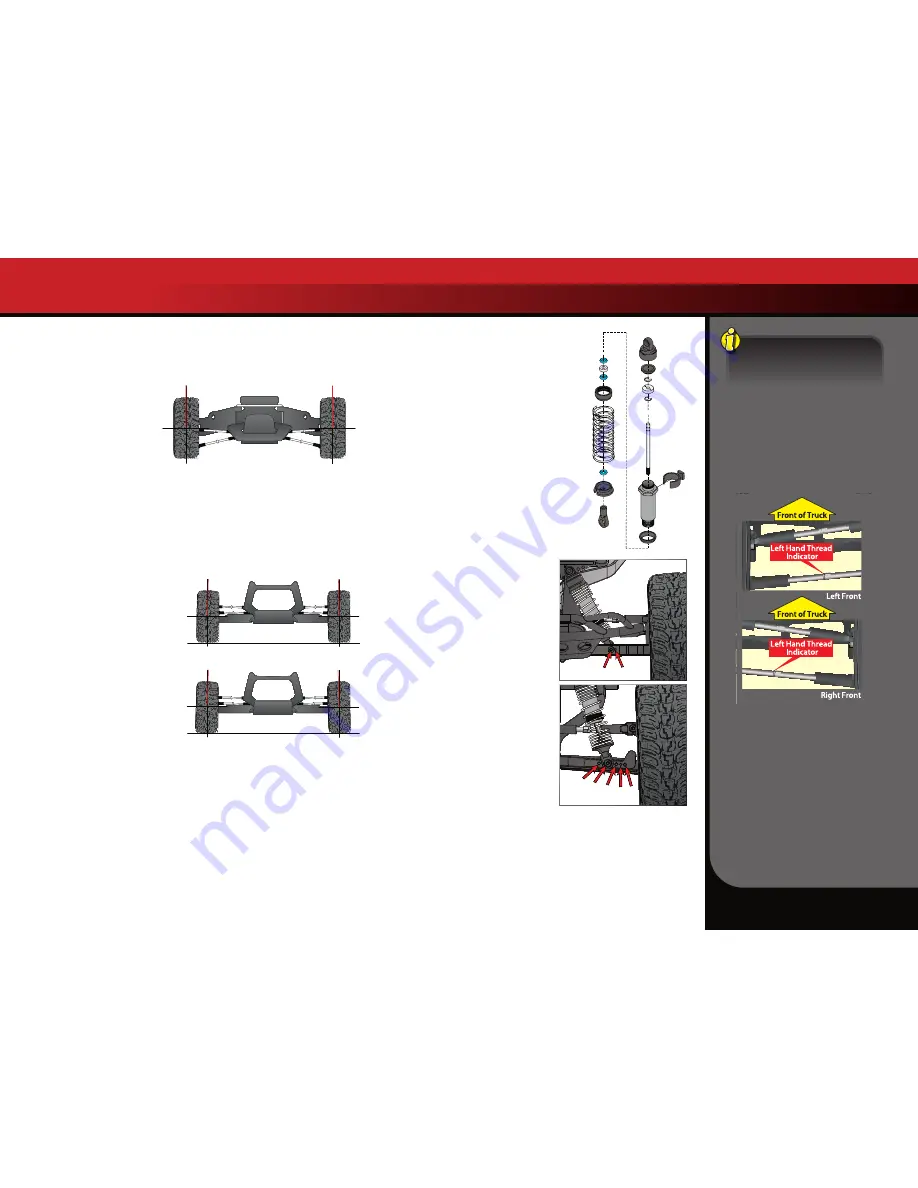
Slash • 19
ADJUSTING YOUR MODEL
Once you become familiar with driving your model, you might
need to make adjustments for better driving performance
Adjusting the Toe-in
Geometry and
alignment specs play
an important roll in
your model’s handling.
Take the time to set
them correctly. Set
the steering trim on
your transmitter to neutral. Now, adjust your servo and tie rods so
that both wheels are pointing straight ahead and are parallel to
each other (0-degrees toe-in). This will ensure the same amount of
steering in both directions. For increased stability add one- to two-
degrees of toe in to each front wheel. Use the turnbuckles to adjust
the alignment.
Adjusting the Camber
The camber angle of both
the front and rear wheels can
be adjusted with the camber
rods (upper turnbuckles).
Use a square or right-angle
triangle to set the camber
accurately. The stock camber
of the front wheels is -1
degree of camber. In the
rear, the stock camber is -1.5
degrees. These adjustments
should be set with the truck
positioned at its normal ride
height with a battery installed.
Fine Tuning the Shocks
The four shocks on the model greatly influence its handling.
Whenever you rebuild your shocks, or make any changes to the
pistons, springs or oil, always make changes to them in pairs (front
or rear). Piston selection depends on the range of oil viscosities
that you have available. For example, using a two-hole piston with
a lightweight oil will, at one point, give you the same damping
as a three-hole piston with heavier oil. We recommend using
the two-hole pistons with a range of oil
viscosities from 10W to 50W (available from
your hobby shop). The thinner viscosity oils
(30W or less) flow more smoothly and are
more consistent, while thicker oils provide
more damping. Use only 100% pure silicone
shock oil to prolong seal life. The model’s
ride height can be adjusted by adding
or removing the clip-on, spring pre-load
spacers. Adjust the ride height so that the
suspension arms are slightly above being
parallel to the ground. Observe how the
model handles in turns. Proper set-up will
add stability and help prevent spin outs.
Experiment with different springs and shock
oils to find what works best for your current
track conditions.
Shock Mounting Positions
Big bumps and rough terrain require a
softer suspension with the maximum
possible suspension travel and ride
height. Racing on a prepared track
or on-road use requires a lower ride
height and firmer, more progressive
suspension settings. The more
progressive suspension settings
help reduce body roll (increased roll
stiffness), dive during braking, and
squat during acceleration.
The suspension of your model has
been set up for off-road performance
(position 1 on the front suspension
arms and position 2 on the rear
suspension arms). If you plan on
driving on hard surfaces the following
changes should be made:
1. Move the front shocks to the outermost (2)
position on the suspension arms.
2. Move the rear shocks to the middle position (3)
on the suspension arms.
3. Add a 4mm preload spacer to the front shock.
Pre-load
Spacer
-1.5
°
-1.5
°
-1
°
-1
°
0
°
0
°
Rear Camber
-1.5
°
-1.5
°
-1
°
-1
°
0
°
0
°
Front Camber
-1.5
°
-1.5
°
-1
°
-1
°
0
°
0
°
Toe-in
All of the toe links are installed
on the truck so the left hand
thread indicators point to the
same direction. This makes it
easier to remember which way
to turn the wrench to increase
or decrease toe link length
(the direction is same at all
four corners). Note that the
groove in the hex indicates
the side of the toe link with
the left-hand threads.
1
1
Front
Rear
2
2 3 4 5






































